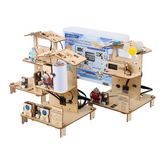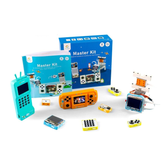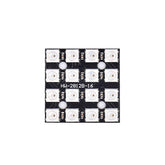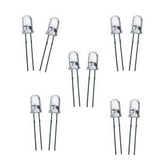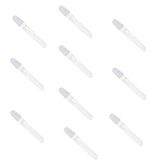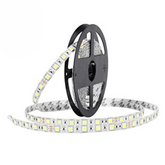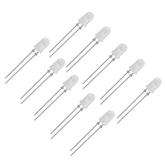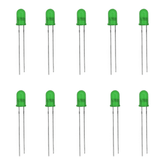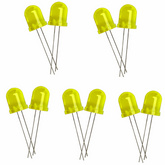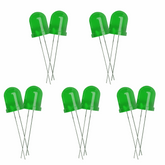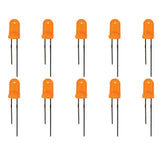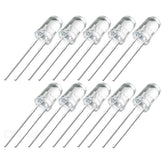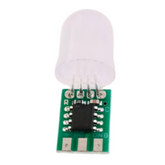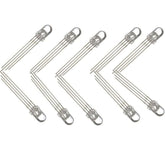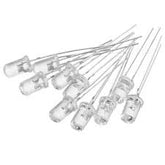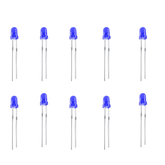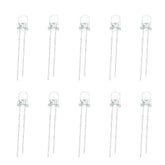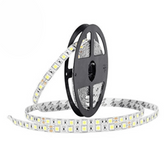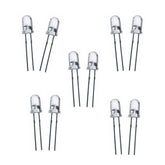-
WS2812 16 Bit RGB LED MatrixWS2812 16 Bit RGB LED Matrix You can create animations, and games, or even incorporate them into a fun e-textiles project. On top of all that, thanks to its flexible backing, this LED Matrix can be bent and bowed to fit onto almost any...
- Rs. 73
Rs. 99- Rs. 73
- Unit price
- per
Save Rs. 26 -
-
5mm RGB LED Common Cathode Diffuse (Pack of 10)5mm RGB LED – Common Cathode – Diffuse (Pack of 10) The 5mm RGB LED Common Cathode-Diffuse (Pack of 10) is the ideal solution for DIY enthusiasts and hobbyists looking to add vibrant lighting effects to their projects. This versatile RGB LED measures 5...
- Rs. 32
Rs. 39- Rs. 32
- Unit price
- per
Save Rs. 7 -
12V Cold White 5050 SMD LED Strip Flexible 5M/Roll Non-Waterproof (5 Meter)12V Cold White 5050 SMD LED Strip Flexible 5M/Roll Non-Waterproof (5 Meter) This Bright 5050 SMD LED, has high intensity and reliability. It has a significantly longer life span of around 50,000 hours than ordinary LED strips available in the market and therefore it can be...
- Rs. 489
Rs. 999- Rs. 489
- Unit price
- per
Save Rs. 510 -
24V Warm White 5050 SMD LED Strip Flexible 5M/Roll NO Waterproof24V Warm White 5050 SMD LED Strip Flexible 5M/Roll NO Waterproof This Bright 5050 SMD LED, has high intensity and reliability. It has a significantly longer life span of around 50,000 hours than ordinary LED strips available in the market and therefore it can be...
- Rs. 459
Rs. 899- Rs. 459
- Unit price
- per
Save Rs. 440 -
5mm White Blue Led (Pack of 10)5mm White Blue Led (Pack of 10) A white-blue light-emitting diode (LED) is a semiconductor light source. LED's are used as indicator lamps in many devices and are increasingly used for other lighting. It looks like a white led and illuminate's blue light. When...
- Rs. 13
Rs. 20- Rs. 13
- Unit price
- per
Save Rs. 7 -
3mm Green LED (Pack of 10)3 mm Green LED (Pack of 10) A Green light-emitting diode (LED) is a semiconductor light source. LED's are used as indicator lamps in many devices and are increasingly used for other lighting. It looks like a white led and illuminate's blue light. When...
- Rs. 13
Rs. 15- Rs. 13
- Unit price
- per
Save Rs. 2 -
10mm Bright Yellow LED - 10pcs Pack10mm Bright Yellow LED - 10pcs Pack The 10mm Bright Yellow LED is a powerful light that shines in bright yellow. It’s a small semiconductor used as an indicator in many devices and is also used for general lighting. With a transparent lens, it...
- Rs. 49
Rs. 69- Rs. 49
- Unit price
- per
Save Rs. 20 -
10mm Bright Green LED - 10pcs Pack10mm Bright Green LED - 10pcs Pack The 10mm Bright Green LED - 10pcs Pack includes super bright LEDs that shine with a wide beam. They are perfect for projects, lighting up models, headlamps, spotlights, car lighting, and more. These LEDs use low power...
- Rs. 49
Rs. 69- Rs. 49
- Unit price
- per
Save Rs. 20 -
3mm Orange Led (Pack of 10)3mm Orange Led (Pack of 10) An Orange light-emitting diode (LED) is a semiconductor light source. LED's are used as indicator lamps in many devices and are increasingly used for other lighting. It looks like a white led and illuminate's blue light. When a...
- Rs. 14
Rs. 19- Rs. 14
- Unit price
- per
Save Rs. 5 -
RGB LED (Common Anode ) (Pack of 10)RGB LED (Common Anode ) (Pack of 10) RGB LED (Common Anode) makes some beautiful colors, this 10mm tri-color LED with separate red, green and blue LED chips inside! They make a nice indicator, and are fun to color-swirl. We like RGB LEDs because...
- Rs. 29
Rs. 46- Rs. 29
- Unit price
- per
Save Rs. 17 -
5mm White Led (Pack of 10)5mm White Led (Pack of 10) A white light-emitting diode (LED) is a semiconductor light source. LEDs are used as indicator lamps in many devices and are increasingly used for other lighting. It looks like a white LED and illuminates blue light. When a light-emitting...
- Rs. 30
Rs. 39- Rs. 30
- Unit price
- per
Save Rs. 9 -
5V RGB led node module5V RGB led node module Using three PWM lines you can control three primary colours and eventually generate any colour that you require. The module is compatible to Arduino & Raspberry Pi no extra circuit required.
- Rs. 75
Rs. 100- Rs. 75
- Unit price
- per
Save Rs. 25 -
RGB LED (Common Cathode - Clear) (Pack of 10)RGB LED (Common Cathode - Clear) (Pack of 10) RGB LED ( Common Cathode - Clear), These LEDs have four pins - Cathode is the longest pin. One for each color and a common cathode. Use this one LED Cathode for three status indicators...
- Rs. 29
Rs. 46- Rs. 29
- Unit price
- per
Save Rs. 17 -
5mm White Green LED(Pack of 10)5mm White Green LED (Pack of 10) A white Green light-emitting diode (LED) is a semiconductor light source. LED's are used as indicator lamps in many devices and are increasingly used for other lighting. It looks like a white led and illuminate's blue light....
- Rs. 14
Rs. 17- Rs. 14
- Unit price
- per
Save Rs. 3 -
3mm DIP Diffused Blue Led (Pack of 10)3mm DIP Diffused Blue Led (Pack of 10) A Blue light-emitting diode (LED) is a semiconductor light source. LEDs are used as indicator lamps in many devices and are increasingly used for another lighting. It looks like a blue led and it luminate blue...
- Rs. 14
Rs. 17- Rs. 14
- Unit price
- per
Save Rs. 3 -
12V Warm White 5050 SMD LED Strip Flexible 5M/Roll Waterproof (5 Meter)12V Warm White 5050 SMD LED Strip Flexible 5M/Roll Waterproof (5 Meter) This Bright 5050 SMD LED, has high intensity and reliability. It has a significantly longer life span of around 50,000 hours than ordinary LED strips available in the market and therefore it can...
- Rs. 577
Rs. 649- Rs. 577
- Unit price
- per
Save Rs. 72 -
3mm White LED (Pack of 10)3mm White LED (Pack of 10) The 3mm White light-emitting diode (LED) is a semiconductor light source. LED's are used as indicator lamps in many devices and are increasingly used for other lighting. It looks like a white led and illuminate's blue light. When a...
- Rs. 17
Rs. 24- Rs. 17
- Unit price
- per
Save Rs. 7 -
12V Warm White 5050 SMD LED Strip Flexible 5M/Roll NO Waterproof12V Warm White 5050 SMD LED Strip Flexible 5M/Roll NO Waterproof This Bright 5050 SMD LED, has high intensity and reliability. It has a significantly longer life span of around 50,000 hours than ordinary LED strips available in the market and therefore it can be...
- Rs. 449
Rs. 999- Rs. 449
- Unit price
- per
Save Rs. 550 -
3mm White Green LED (Pack of 10)3mm White Green LED (Pack of 10) The 3mm White green light-emitting diode (LED) is a semiconductor light source. LED's are used as indicator lamps in many devices and are increasingly used for other lighting. It looks like a white led and illuminate's blue light. When...
- Rs. 18
Rs. 24- Rs. 18
- Unit price
- per
Save Rs. 6

Best Price Guarantee

Ready Stock for Bulk Purchase

Dedicated Account Managers

5% GST Benefits for Eligible SEZ and Edu

Technical Support Available

1-Year Manufacturer Warranty



